book4teachingplan教学设计教案
大班英语优质课教案《TeachingPlan》
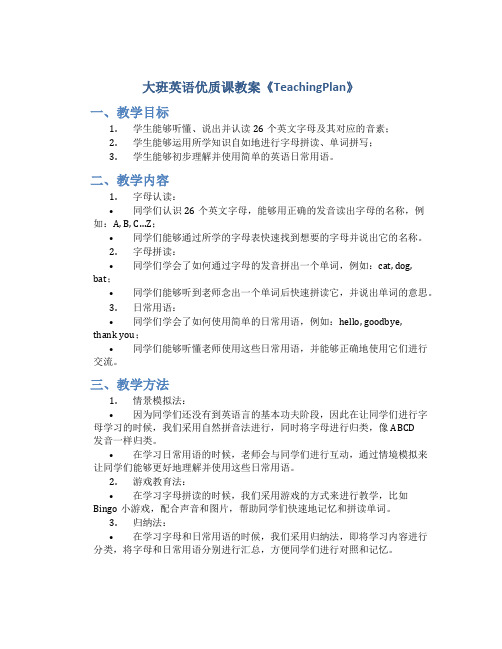
大班英语优质课教案《TeachingPlan》一、教学目标1.学生能够听懂、说出并认读26个英文字母及其对应的音素;2.学生能够运用所学知识自如地进行字母拼读、单词拼写;3.学生能够初步理解并使用简单的英语日常用语。
二、教学内容1.字母认读:•同学们认识26个英文字母,能够用正确的发音读出字母的名称,例如:A, B, C…Z;•同学们能够通过所学的字母表快速找到想要的字母并说出它的名称。
2.字母拼读:•同学们学会了如何通过字母的发音拼出一个单词,例如:cat, dog, bat;•同学们能够听到老师念出一个单词后快速拼读它,并说出单词的意思。
3.日常用语:•同学们学会了如何使用简单的日常用语,例如:hello, goodbye,thank you;•同学们能够听懂老师使用这些日常用语,并能够正确地使用它们进行交流。
三、教学方法1.情景模拟法:•因为同学们还没有到英语言的基本功夫阶段,因此在让同学们进行字母学习的时候,我们采用自然拼音法进行,同时将字母进行归类,像ABCD发音一样归类。
•在学习日常用语的时候,老师会与同学们进行互动,通过情境模拟来让同学们能够更好地理解并使用这些日常用语。
2.游戏教育法:•在学习字母拼读的时候,我们采用游戏的方式来进行教学,比如Bingo小游戏,配合声音和图片,帮助同学们快速地记忆和拼读单词。
3.归纳法:•在学习字母和日常用语的时候,我们采用归纳法,即将学习内容进行分类,将字母和日常用语分别进行汇总,方便同学们进行对照和记忆。
四、教学步骤1. 字母认读1.听老师读出26个英文字母的名称,同学们跟读;2.分组比赛,根据老师所说的字母名称,第一个跟读出来的小组获胜;3.学生自由读出由老师即兴出现的随意字母。
2. 字母拼读1.老师播放音频,让学生们听声音,说出音频中的每个单词中的字母;2.BINGO小游戏,根据音频快速拼读单词并标记;3.学生自己编写单词进行拼读及说出意思。
Teaching plan of unit4
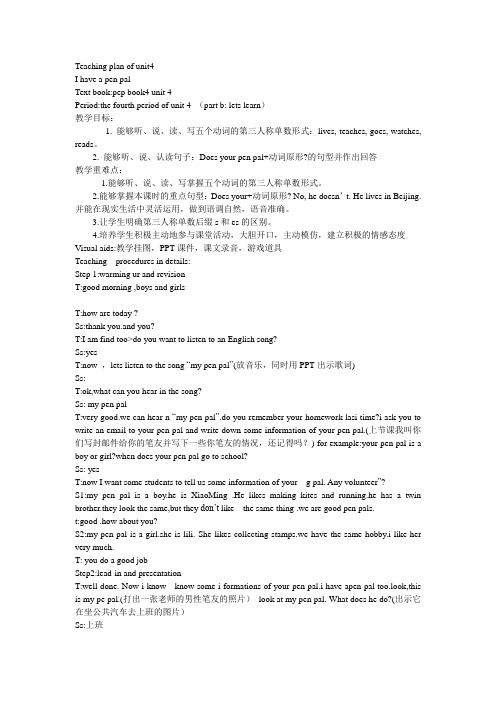
Teaching plan of unit4I have a pen palText book:pep book4 unit 4Period:the fourth period of unit 4 (part b: lets learn)教学目标:1. 能够听、说、读、写五个动词的第三人称单数形式:lives, teaches, goes, watches, reads。
2. 能够听、说、认读句子:Does your pen pal+动词原形?的句型并作出回答教学重难点:1.能够听、说、读、写掌握五个动词的第三人称单数形式。
2.能够掌握本课时的重点句型:Does your+动词原形? No, he doesn’t. He lives in Beijing.并能在现实生活中灵活运用,做到语调自然,语音准确。
3.让学生明确第三人称单数后缀s和es的区别。
4.培养学生积极主动地参与课堂活动,大胆开口,主动模仿,建立积极的情感态度Visual aids:教学挂图,PPT课件,课文录音,游戏道具Teaching procedures in details:Step 1:warming ur and revisionT:good morning ,boys and girlsT:how are today ?Ss:thank you.and you?T:I am find too>do you want to listen to an English song?Ss:yesT:now ,lets listen to the song “my pen pal”(放音乐,同时用PPT出示歌词)Ss:T:ok,what can you hear in the song?Ss: my pen palT:very good.we can hear n “my pen pal”.do you remember your homework lasi time?i ask you to write an email to your pen pal and write down some information of your pen pal.(上节课我叫你们写封邮件给你的笔友并写下一些你笔友的情况,还记得吗?) for example:your pen pal is a boy or girl?when does your pen pal go to school?Ss: yesT:now I want some students to tell us some information of your g pal. Any volunteer”?S1:my pen pal is a boy.he is XiaoMing .He likes making kites and running.he has a twin brother.they look the same,but they don’t like the same thing .we are good pen pals.t:good .how about you?S2:my pen pal is a girl.she is lili. She likes collecting stamps.we have the same hobby.i like her very much.T: you do a good jobStep2:lead-in and presentationT:well done. Now i know know some i formations of your pen pal.i have apen pal too.look,this is my pe pal.(打出一张老师的男性笔友的照片)look at my pen pal. What does he do?(出示它在坐公共汽车去上班的图片)Ss:上班T:good.he goes to work(板书goes to work.用红笔标出es) look at the picture again. How does he go to work?Ss: by busT: yes.he goes to work by bus. Look ,what else can you see?(出示更多的图片关于老师的笔友用其他交通工具去上班的图片)Ss:T:he sometimes goes to work by subway.(停顿一下)。
Book4Unit3teachingplan
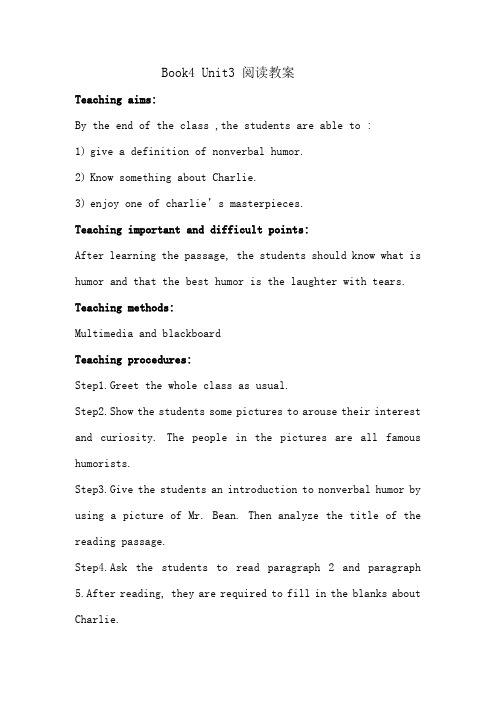
Book4 Unit3 阅读教案Teaching aims:By the end of the class ,the students are able to :1)give a definition of nonverbal humor.2)Know something about Charlie.3)enjoy one of charlie’s masterpieces.Teaching important and difficult points:After learning the passage, the students should know what is humor and that the best humor is the laughter with tears. Teaching methods:Multimedia and blackboardTeaching procedures:Step1.Greet the whole class as usual.Step2.Show the students some pictures to arouse their interest and curiosity. The people in the pictures are all famous humorists.Step3.Give the students an introduction to nonverbal humor by using a picture of Mr. Bean. Then analyze the title of the reading passage.Step4.Ask the students to read paragraph 2 and paragraph 5.After reading, they are required to fill in the blanks about Charlie.Step6.Play a mime starred by Charlie and then ask the students to find out some basic information about Charlie. This is a pair work—one student asks the question, the other one answers. Then role exchanges.Step7.Ask the students a question: How do you feel after watching the movie? The aim is to enrich the students’thoughts, guide them to think while reading.Step8.Fun timeAsk the students to share their own jokes and funny stories. Step9.HomeworkWhat can we learn from Charlie chaplin?。
高一必修四Teaching Plan优秀教案
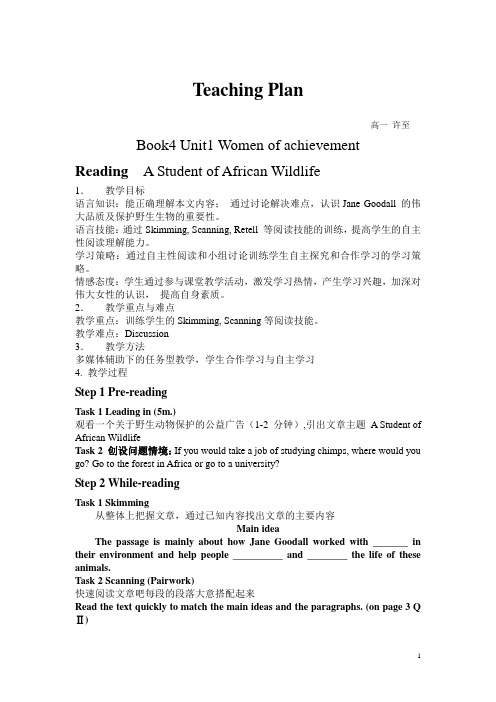
Teaching Plan高一许至Book4 Unit1 Women of achievement Reading A Student of African Wildlife1.教学目标语言知识:能正确理解本文内容;通过讨论解决难点,认识Jane Goodall 的伟大品质及保护野生生物的重要性。
语言技能:通过Skimming, Scanning, Retell 等阅读技能的训练,提高学生的自主性阅读理解能力。
学习策略:通过自主性阅读和小组讨论训练学生自主探究和合作学习的学习策略。
情感态度:学生通过参与课堂教学活动,激发学习热情,产生学习兴趣,加深对伟大女性的认识,提高自身素质。
2.教学重点与难点教学重点:训练学生的Skimming, Scanning等阅读技能。
教学难点:Discussion3.教学方法多媒体辅助下的任务型教学,学生合作学习与自主学习4. 教学过程Step 1 Pre-readingTask 1 Leading in (5m.)观看一个关于野生动物保护的公益广告(1-2 分钟),引出文章主题 A Student of African WildlifeTask 2 创设问题情境:If you would take a job of studying chimps, where would you go? Go to the forest in Africa or go to a university?Step 2 While-readingTask 1 Skimming从整体上把握文章,通过已知内容找出文章的主要内容Main ideaThe passage is mainly about how Jane Goodall worked with _______ in their environment and help people __________ and ________ the life of these animals.Task 2 Scanning (Pairwork)快速阅读文章吧每段的段落大意搭配起来Read the text quickly to match the main ideas and the paragraphs. (on page 3 Q Ⅱ)A student of African wildlifeTask 3 Comprehending1.What did the group do first in the morning? They __C___.A.went into the forest slowlyB.left the chimp family sleeping in the treeC.observed the family of chimps wake upD.helped people understand the behaviour of the chimps2. Why did Jane go to Africa to study chimps in the wild? Because she wanted A .A.to work with them in their own environmentB.to prove the way people think about chimps was wrongC.to discover what chimps eatD.to observe a chimp family3. Jane was permitted to begin her work after __C__.A. The chimp family woke upB. she lived in the forestC. Her mother came to support herD. she arrived at Gombe4. The purpose of her study was to __C__.A. Watch the wild chimps in cagesB. Gain a doctor’s degreeC. Understand and respect the lives of chimpsD. ive in the forest as men can Task 4Details-readingThe first paragraph The whole dayThe third paragraph True or false:1. She hopes that chimps can be left in the forest.2. She has helped build many homes for the wild animals to live in.3. She has spent about forty years helping people understand her work.4. Once she stop working, all the scenes of chimps in the laboratories will appear in her mind.The fourth paragraph Jane’s achievements:Working with animals in their own environment. Gaining a doctor’s degree. Showing that women can live in the forest as men can.Step 3 Post reading学生通过略读查读和细读,抓住了文章脉络,理解了文章内容,在此基础上,要求学生快速完成练习。
Unit4Teachingplan(人教版高三英语教案教学设计)
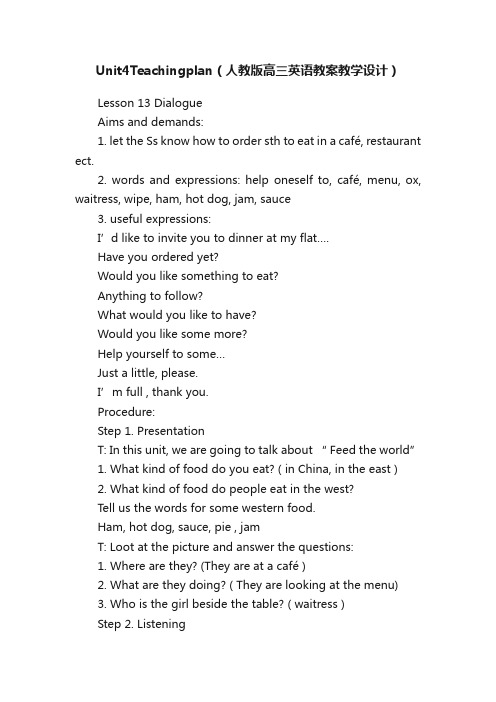
Unit4Teachingplan(人教版高三英语教案教学设计)Lesson 13 DialogueAims and demands:1. let the Ss know how to order sth to eat in a café, restaurant ect.2. words and expressions: help oneself to, café, menu, ox, waitress, wipe, ham, hot dog, jam, sauce3. useful expressions:I’d like to invite you to dinner at my flat….Have you ordered yet?Would you like something to eat?Anything to follow?What would you like to have?Would you like some more?Help yourself to some…Just a little, please.I’m full , thank you.Procedure:Step 1. PresentationT: In this unit, we are going to talk about “ Feed the world”1. What kind of food do you eat? ( in China, in the east )2. What kind of food do people eat in the west?Tell us the words for some western food.Ham, hot dog, sauce, pie , jamT: Loot at the picture and answer the questions:1. Where are they? (They are at a café )2. What are they doing? ( They are looking at the menu)3. Who is the girl beside the table? ( waitress )Step 2. ListeningListen to the tape and answer the question;What are Wang Bing’s plans for the future?He’s going to start work at the Farm Institute next month.Do the listening comprehension: Lesson 13 (3A) DBCBB1. What are Wa ng Bing and Carl doing in a café? They are _____.A. having a talkB. sitting thereC. waiting for a friendD. having lunch2. Wang Bing says he is ___ to eat an ox.A. too hungryB. hungry enoughC. rather hungryD. enough hungry3. What is Carl going to have?A. a hot dogB. a potato saladC. a ham saladD. a ham4. Who will start work at the Farm Institute next month?A. CarlB. Wang BingC. the waiterD. the waitress5. Carl suggests fixing a date. What are they going to do?They are going to have dinner ___.A. togetherB. at Wang Bing’s flatC. in a caféD. at Carl’s flatStep 3. DialogueRead after the tape and then answer some questions.Step 4. Language points1. Have you ordered yet?He ordered a glass of beer.Shall we order our dinner now?Has the waitress brought your order?Not yet.I ordered some new clothes a month ago.2. Are you hungry?3. I’ll take your order.I’ll write down which food you want and pass it to the kitchen.4. Anything to follow?5. now and again: from time to time / now and then6. invite sb. to dinnerStep 5. PracticeStep 6. WorkbookExtra exercises (3A Unit 4) AAD ACBAD CCD1. I’m just looking at the menu. ( L 13)2. I’m looking forward to that. (L 13 )3. ___ this book and tell me what you think of it.( 90)A. Look throughB. Look onC. Look intoD. Look up4. ____! There’s a train coming. ( 91)A. Look outB. Look aroundC. Look forwardD. Look on5. Many foreigners ____ the Great Wall as the World’s Seventh Wonder. ( 92)A. look atB. look forC. look aroundD. look on6. We all ____ her ____ our best friend.A. look on, asB. look up, toC. look for , asD. look at, in7. We should ____ our teachers.A. look upB. look down uponC. look up toD. look out8. Li Lei will ____ the dog when we are away.A. look throughB. look afterC. look aboutD. look into9. “What are you ____?” “ The dictionary.”A. looking forB. looking onC. looking aroundD. looking up10. What does the weather ____ today?A. look onB. look back toC. look forD. look like11. I will have my bad tooth ____.A. looked backB. looked atC. looked throughD. looked on12. ____ this book and tell me if it is worth reading.A. Look atB. Look outC. Look throughD. Look up to13. The boy is old enough to ___ himself.A. look onB. look forC. look forward toD. look afterHomework Finish the Wb and the paper exerciseLesson 14 Feed the world (1)Aims and demands:1. Develop the Ss’ reading ability and let the Ss know the problem of feeding the world2. useful expressions:in a word , ruin, damp , loss, day by day , irrigate, storageProcedure:Step 1. Presentation:T: As we know the population of the world is about 5.7 billion. Two thirds of the earth’s surface is covered by water, and only about 11% of the earth’s land surface is suitable for growin g crops. And this area is becoming smaller and smaller day by day. Then let’s come to seeWhy is the area of farmland in the world getting smaller?And how to feed a growing world population?Step 2. Listen to the tape and tell the general idea of each paragraph1. General description of food production.2. Farmland is lost for several reasons.3. Hunger is a big problem in the world today.4. Various things can be done to increase the food supply.5. Scientists continue to develop new types of plants.Step 3. Careful readingRead it carefully and do the note makingFacts: (page 21)Reasons for loss of farmland---- Why is the area of farmland in the world getting smaller?1. It is being built on.2. It is being lost by the actions of the wind and the rain.3. Land is becoming too salty.Ways of increasing food production ----What are some of the ways of increasing food production?1. You can increase the area of farmland by irrigation;2. You can build dams and water your fields;3. You can pump water from low-lying area;4. You can develop new plants which produce heavier crops;5. You can develop new plants which grow in poor soil;6. You can develop new plants which are less likely to be attacked by pests and diseases;Step 4. Reading comprehensionReading comprehension: ( 3A Unit 4 --- Lesson 14) DCBCD BDBDC1. People first began to grow crops in ___.A. AsiaB. EuropeC. AfricaD. both A and C2. This text is mainly about ___.A. agricultural developmentB. farmland problemsC. the problems in agriculture and some solutionsD. the present agricultural situation and problems3. The difficulty in solving feeding problem mentioned in paragraph 1 is that ___.A. the growing world population is too bigB. the farmland in the world is limitedC. the development of farming can’t catch up with the population growthD. farming development is too slow4. The suitable farming land is about __ of the earth surface.A. 1.5% C. 2.5% C. 3.5% D. 4.5%5. What can’t we do to stop the loss of farmland according to the text?A. Make careful plans for building.B. Plant more trees.C. Make the land rich.D. Develop some man-made land.6. What does “remove” in paragraph 2 mean?A. get rid ofB. take awayC. moveD. move again7. Crops are damaged ___ .A. before growing C. during growingC. after growingD. both B and C8. How many examples are given to show that irrigation and some other ways can increase the area of farmlands?A. TwoB. ThreeC. FourD. None9. New types of plants being developed should be better in___.A. quantityB. qualityC. sizeD. both A and B10. The word with the same meaning as “irrigate” is ___.A. increaseB. growC. waterD. pumpStep 5. Language points:1. earn one’s (a) livingmake one’s (a) livingT: How do I make a living?Ss:__________He began to earn his living at the age of twelve.They earned their living by hunting.2. for one thing 首先。
小学英语Book4Module2Unit1教学设计人教版
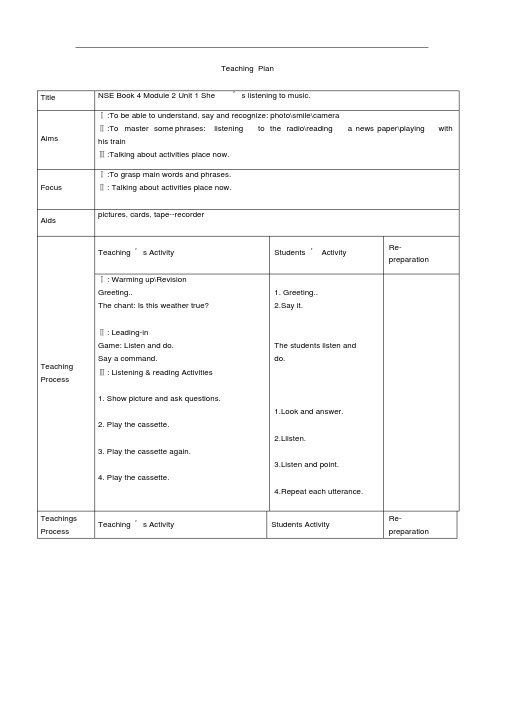
Teaching PlanTitle NSE Book 4 Module 2 Unit 1 She’s listening to music.Aims Ⅰ:To be able to understand, say and recognize: photo\smile\cameraⅡ:To master some phrases: listening to the radio\reading a news paper\playing with his trainⅢ:Talking about activities place now.Focus Ⅰ:To grasp main words and phrases. Ⅱ: Talking about activities place now.Aidspictures, cards, tape--recorderTeaching Process Teaching’s Activity Students’ ActivityRe-preparation Ⅰ: Warming up\RevisionGreeting..The chant: Is this weather true?Ⅱ: Leading-inGame: Listen and do.Say a command.Ⅲ: Listening & reading Activities1. Show picture and ask questions.2. Play the cassette.3. Play the cassette again.4. Play the cassette.1. Greeting..2.Say it.The students listen anddo.1.Look and answer.2.Llisten.3.Listen and point.4.Repeat each utterance.Teachings Process Teaching’s Activity Students ActivityRe-preparation5. Write the phrases and teach.6. Teach sentences.7. Turn on the tape.Ⅳ: Further DevelopmentSB: Listen and say.SB: Practise.Have a race.Ⅴ: HomeworkOwn f amily who describe the affair does tonight.2. AB (U2) 5.Learn carefully.6.Learn and drill.7.Listen and repeat.1.Do it.2. Work in pairs.3.Do it.Listen carefully.Feed backTeaching PlanTitle NSE Book 4 Module 2 Unit 2Aims i. To master: drawing writing playing reading listening. ii. Talking about the on-going activities of somebody.Focus To understand and use main knowledge correctly. Aids cards . tapeTeaching Process Teacher’s ActivityI.Warming up and Revision1.Greeting.2.ChantII.Leading-in1.Review :play/sing/watch/listen…Lead the class to say v-ing.Say something about the text.III.Listening & Reading Activities1.Show the picture and play thetape.2.Questions for children.3.Write “I’m___ing.”on theboard.4.Play the ape again.5.A few minutes for children.IV.Further Development1.Lead the class in a discussionabout A2.2.Teach this song.AB U2 E1&2.V.HomeworkTalking about the on-goingactivities of family members.Students’ Activity1.Greeting.2.Say and do the actions.1.To review them.2.Listen..1.Listen.2.Discuss and answer.3.Look and repeat.4.Listen again.5. practise in pairs and act.1.Work in pairs.2.Learn to sing.3.Do them.Re-preparationTeaching PlanTitle NSE Book 4 Module4 unit 1Aims i.To master main knowledge--What are you doing ?\What’s he/she doing?ii.To use main knowledge freely.Focus i.Ask and answer the present action.i.The pronunciation of the V+ingAids Cards, Tape-recorderTeaching Process Teacher’s ActivityI.Warming up and Revision1、Greeting.2、A song.3、Let children use--Are you V+ing ? and--Yes./No. to ask and answer.II.Leading-inReview --V+ing .eg.“swimming,jumping ,walking ”.Etc.III. Listening and readingActivities1、Turn on the tape.2 、Turn on the tape again.3、Teach new sentences :4、Activity2—Listen and say.IV. .Further Development1、Show the pictures of part 32、Have a race.V. HomeworkDeclare homework:Students’ Activity1、Greeting.2、Clap and sing3、Do it in pairs.Read these words.1、listen and point2 、Listen and underlinenew knowledge.3、Learn and drill them.4、Work in pairs.1、Practise and show it.2、Do it.Re—preparationFeed Back1、Listen and read the text.2、AB(P14,15). Listen carefully.Feed backTitleModule4 Unit2 What ’s she doing ?Aims 1.Learn the new words and sentences, then say.2.Let students can talk about occupations.Focus 1.Words: noice、drink、talk、there、game .2.Sentences: What’s she doing?She’s playing a game with Amy and Sa m. Aids Radio、cards、VCD、tapes、chalksTeaching Process Teacher’s ActivityI Warming up andRevisioni. Greetingsii Sing the songII Leading-inShow the picture.T: What’s are theydoing?Students’ActivityS: Say “hello” toteacher.S:Sing and do.S: They are talking.Re-preparationTeaching PlanTeaching Process T: What’s she doing?T: Now we will learnMoudle 4 Unit 2<What’s she doing?>III Listening andActivities.Turn on the tape.IV Further DevelopmentInvite three students tothe front of the class.Tell them to mime anaction.Stop them and ask themthis.S: she’s playing.Listen and learn.Do the action.Answer.Teaching Process Game: Say and guess.Show a picture and askthe students.T: What’s she doing?Say and sing the chant.V HomeworkRead the dialogue andthe sentence .Preview Module 5 Unit1.She’s playing basketball.Sing the chantFeed back。
book4 unit 4 body language using language teaching plan
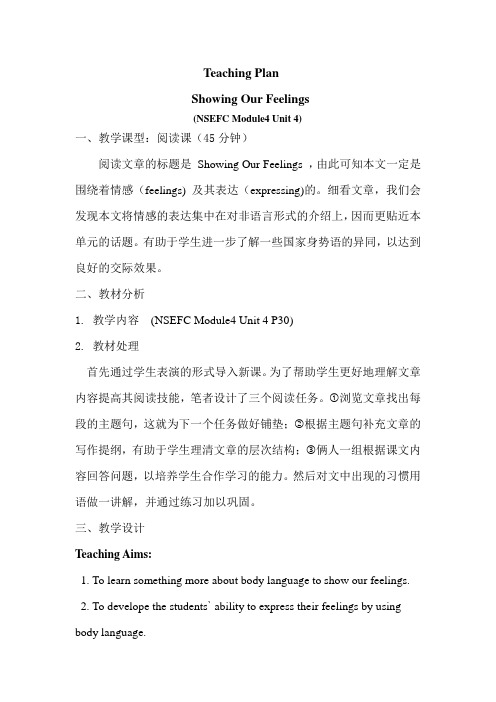
Teaching PlanShowing Our Feelings(NSEFC Module4 Unit 4)一、教学课型:阅读课(45分钟)阅读文章的标题是Showing Our Feelings,由此可知本文一定是围绕着情感(feelings)及其表达(expressing)的。
细看文章,我们会发现本文将情感的表达集中在对非语言形式的介绍上,因而更贴近本单元的话题。
有助于学生进一步了解一些国家身势语的异同,以达到良好的交际效果。
二、教材分析1. 教学内容(NSEFC Module4 Unit 4 P30)2. 教材处理首先通过学生表演的形式导入新课。
为了帮助学生更好地理解文章内容提高其阅读技能,笔者设计了三个阅读任务。
①浏览文章找出每段的主题句,这就为下一个任务做好铺垫;②根据主题句补充文章的写作提纲,有助于学生理清文章的层次结构;③俩人一组根据课文内容回答问题,以培养学生合作学习的能力。
然后对文中出现的习惯用语做一讲解,并通过练习加以巩固。
三、教学设计Teaching Aims:1. To learn something more about body language to show our feelings.2. To develope the students` ability to express their feelings by using body language.Teaching Focuses:1. Train the students’ reading ability.2. Master the following language points:It is +adj. +to do, put sb. at ease, turn one’s back to, give a hug to, be willing to doDifficult Points:1.Help the students to finish the outline of the passage.2.Enable the students to use body language to express their thoughtsand opinions and to communicate with other people.Teaching Methods:Game, pair work, reading and explanation.Teaching steps:StepⅠ: Lead-inShow the students some phrases and invite some volunteers to act them out without speaking. Others try to guess what did he/she want to express.Come here. Go away. I’m tired. OK. I’m sad.You’re great! Blow a kiss. Shake one’s head. Wink.Goodbye!(T: Though they did not speak, they showed their feelings by using body language, and we could guess what they wanted to express. So today we will read a passage about how to express our feelings. Bb: SHOWINGOUR FEELINGS. )StepⅡ: Reading tasks1.Scan the text and get the topic sentence of each paragraph.Para.1 Of course, body language can be misread, but many gestures and actions are universal.Para.2 The most universal facial expression is, of course, the smile-its function is to show happiness and put people at ease.Para.3 From the time we are babies, we show unhappiness or anger by frowning.Para.4 There are many ways around the world to show agreement, but nodding the head up and down is used for agreement almostworldwide.Para.5 How about showing that I am bored? Looking away from people or yawning will, in most cases, make me appear to beuninterested.Para6. Being respectful to people is subjective, based on each culture, but in general it is probably not a good idea to give a hug to aboss or teacher.Para7. With so many cultural differences between people, it is great to have some similarities in body language.2. Berore writing, authors usually make a writing outline. Please read the passage carefully and complete the outline in your own words, usingthese steps:●Using the topic sentences of the first and last paragraphs to help youwrite the main idea.●Use the topic sentences of the middle paragraphs for the supportingpoints.Main idea: Body language has many universal gestures.Points: 1 Showing happiness2 Showing unhappiness or anger3 Showing agreement or disagreement4 Showing boredom5 Showing respect3. Work in pairs. Use what you have read in the passage to help you answer the following questions.Q1. What is the general purpose of smiling?Q2. Does smiling always mean that we are truly happy? If not, what kinds of feelings can it hide?Q3. How do people show anger, agreement or disagreement?Q4. If you want to show that you are willing to listen, what will you do?Step Ⅲ:Language points1. It is possible to “read” others around us.It is +adj. + to doit在此用作形式主语,真正的主语为后面的动词不定式。
Book4Module7教学设计新部编版
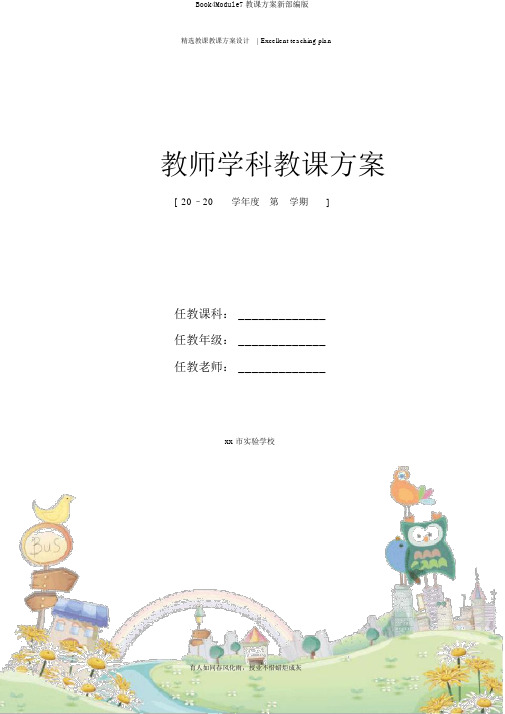
Book4Module7教课方案新部编版精选教课教课方案设计| Excellent teaching plan教师学科教课方案[ 20–20学年度第__学期]任教课科: _____________任教年级: _____________任教老师: _____________xx市实验学校Book4Module7教课方案新部编版精选教课教课方案设计| Excellent teaching planTeaching Plan School : 烈士山Name : 栾易君Title NSE Book 4Module 7Unit 2Aims 1.Learn and talk some phrase“eating sleeping drawing flying a kite”and so on .2. Teach the students a new song.Focus How to use the phrase of actions.Aids Cards Tape-recorder computer stage-propertyTeacher’s Activity Students’Activity Re-preparation一.Warming up(1)Let’s sing songs.(1)Sing songs, together.(2)Ask some questions about(2)Answer the questions andChildren’s Day.do the actions.二. Leading-in(1) Show a picture about picnic. Tell Look and listen carefully.studens “today is sunny.Tingtingis having a picnic with herfamily. Let’s look at what arethey doing?”三.Listening and reading activities.(一) activity1(1)Play the tape.Listen two times and thenanswer(2)Tell the students to listen and Read and translate everyTeaching translate the text.sentencesPlay the tape again.Listen and repeat one by one.(3)process(二) 2Do activity2 ask and answer in pairs.Two students in pairs.Student A ask.Student B answer.(三) activity3Teach the students a new song.(四) activity 4.(1) Show some pictures about Chilren ’sDay. Tell the students that you are going to describe different pictures and they have to listen and point to the correct ones.(2)Do exercisebook 五.Homework.Let students show a pictures about family ’s party. And describe.Sing and do the action.Describe different pictures listen and point to the correct ones.Do exercise bookBook4Module7教课方案新部编版精选教课教课方案设计| Excellent teaching plan Feed book。
Book4 Module6 Unit2教学设计教案,DOC
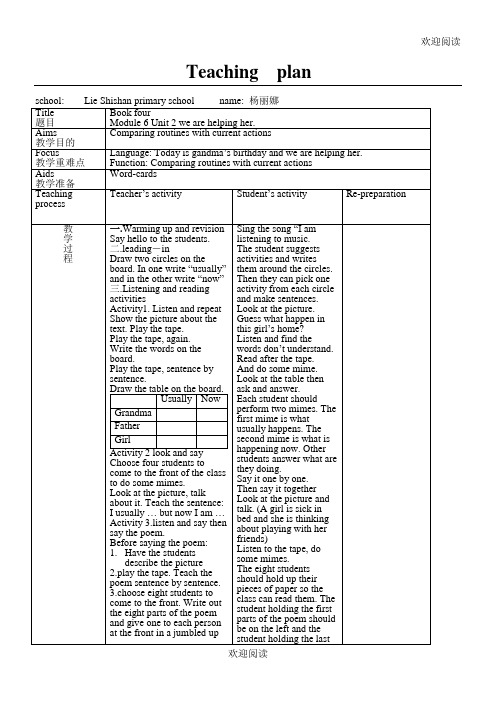
Student’s activity
Re-preparation
教
学
过
程
一.Warming up and revision
Say hello to the students.二.leading-in
Draw two circles on the board. In one write “usually” and in the other write “now”
三.Listening and reading activities
Activity1. Listen and repeat
Show the picture about the text. Play the tape.
Play the tape, again.
Write the words on the board.
The eight students should hold up their pieces of paper so the class can read them. The student holding the first parts of the poem should be on the left and the student holding the last part of the poem should be on the right.
Look at the picture. Guess what happen in this girl’s home?
Listen and find the words don’t understand.
Read after the tape.
And do some mime.
Book4 Module10 Unit2教学设计教案
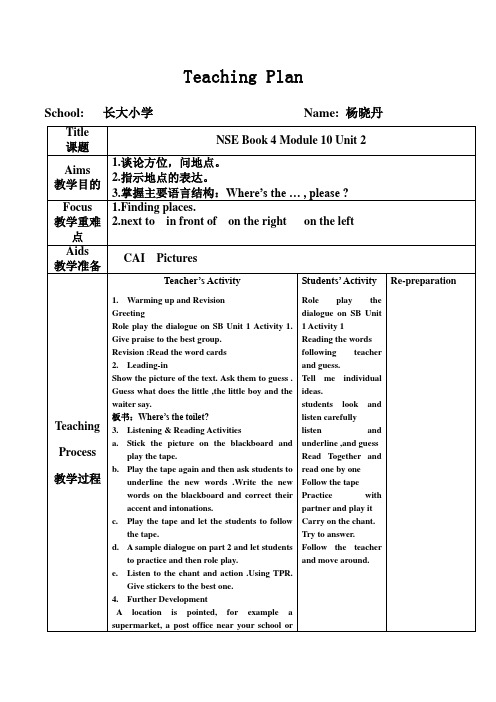
d.A sample dialogue on part 2 and let students to practice and then role play.
e.Listen to the chant and action .Using TPR. Give stickers to the best one.
Aids
教学准备
CAI Pictures
Teaching Process
教学过程
Teacher’s Activity
1.Warming up and Revision
Greeting
Role play the dialogue on SB Unit 1 Activity 1. Give praise to the best group.
4.Further Development
A location is pointed, for example a supermarket, a post office near your school orsomewhere else that the students know. Ask them to show the way.
Game : give instructions to the students and they have to move around and stand in the correct place.
Sum up the major contents needed to learn.
5.Homework
Follow the tape
Teaching plan for Unit 2 Book 4
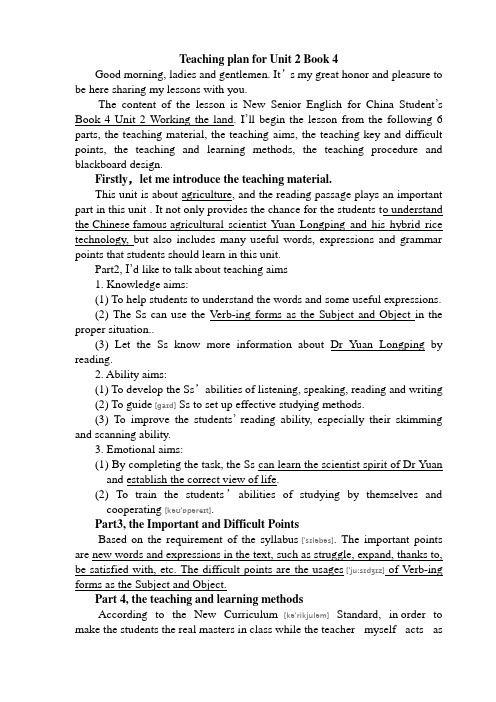
Teaching plan for Unit 2 Book 4Good morning, ladies and gentlemen. It’s my great honor and pleasure to be here sharing my lessons with you.The content of the lesson is New Senior English for China Student’s Book 4 Unit 2 Working the land. I’ll begin the lesson from the following 6 parts, the teaching material, the teaching aims, the teaching key and difficult points, the teaching and learning methods, the teaching procedure and blackboard design.Firstly,let me introduce the teaching material.This unit is about agriculture, and the reading passage plays an important part in this unit . It not only provides the chance for the students to understand the Chinese famous agricultural scientist Yuan Longping and his hybrid rice technology, but also includes many useful words, expressions and grammar points that students should learn in this unit.Part2, I’d like to talk about teaching aims1. Knowledge aims:(1) To help students to understand the words and some useful expressions.(2) The Ss can use the Verb-ing forms as the Subject and Object in the proper situation..(3) Let the Ss know more information about Dr Yuan Longping by reading.2. Ability aims:(1) To develop the Ss’abilities of listening, speaking, reading and writing(2) To guide [gaɪd] Ss to set up effective studying methods.(3) To improve the students’reading ability, especially their skimming and scanning ability.3. Emotional aims:(1) By completing the task, the Ss can learn the scientist spirit of Dr Yuanand establish the correct view of life.(2) To train the students’abilities of studying by themselves andcooperating [kəʊ'ɒpəreɪt].Part3, the Important and Difficult PointsBased on the requirement of the syllabus[ˈsɪləbəs]. The important pointsforms as the Subject and Object.Part 4, the teaching and learning methodsAccording to the New Curriculum[kəˈrikjuləm]Standard, in order to make the students the real masters in class while the teacher myself acts asguide, organizer and the cooperator. I mainly use the following teaching and learning methods in the class:Task-based teaching method, Question-and-answer MethodSelf-dependent [dɪˈpendənt] learning method ,cooperative [kəʊ'ɒpərətɪv]合作learning method and discussion.Part5 Teaching ProcedureThe teaching design of this class by pre-reading, while-reading,post-reading in the reading teaching mode.Step One Lead-inI will lead in the lesson with some pictures of countryside, with the following questions.1.Have you ever been to the countryside? What did you see or do there?2. What do you know about farming?3. Have you ever grow any plants? How would you grow it?.Purpose of my design: To increase the students’ interest and attract their attention and lead in step2.Step 2. Pre-readingTask 1. ( pair work, __3___min)Let Ss read the questions 1 and 2 in pre-reading part, then work in pairs to find out the answers to the questions, then ask several students to express their ideas.Task 2. (Individual work, __2___min)Ask students to read the title and look at the pictures. Predict [prɪ'dɪkt] what the reading will be about. Then read it quickly to check.Purpose of my design: The task is to develop the students’ reading skill by making prediction [prɪˈdɪkʃn].Step 3 while-readingTask 1 (Individual work)Skimming(略读): Ss should read the material fast to find out the main idea sentence for each paragraph.Task 2 (Group work)Scanning: Guide [ɡaid] Ss to read the material carefully and take some important notes. The students will be divided into groups of four, and then finish exercise 1 Page11.Task 3 (Pair work)Scanning: Ask Ss to read the material carefully and find out the correct answers to finish the exercise 3on Page11 .Purpose of my design:Enable students to understand the given material better by using different reading skills. And proper competition canarouse the Ss’ interest in English learning. “Task-based” teaching method is used here to develop the Ss’ ability of communication and also their ability of co-operation will be well trained.Step4 Post-readingTask. Discuss in groups and give a report to the classWhat advantages and disabvantages do you see in Yuan Longping’s life? Would you like to have a life like his? Why or why not?.Purpose of my design: T his part is a good opportunity of the moral education teaching , through the discussion to establish the students’ correct view of life, make the topic of sublimation[ˌsʌblɪ'meɪʃn], achieve the goal of emotional education.Step5. Summary1. Write down what you have learned about working in land.2. Ask Ss to close books and finish the summary according their notesPurpose of my design:I think if the Ss can finish this task well, they will benefit a lot in their spoken English. Most Ss can take their parts in the activities, especially for the Ss who have trouble in English study.Step6. HomeworkReview the new words and expressions in the text.Purpose of my design:Homework is so important and necessary for to master the knowledge they learned after class. It will check whether the Ss achieve the teaching aims.Part 6.Blackboard designBlackboard design should be thank for a thing that attract the student’s attention and let them to write down the important teaching points. I will divide the blackboard into two parts .The left part will be used to write the important vocabulary and grammar . It will be reserved for the whole class. The right part will be precious explanation, I will write some sentence of the words, phrases and structures to explain their meaning.That’s all for my teaching design. Thank you.。
大学英语新book4电子教案

课时安排:2课时教学目标:1. 培养学生阅读理解能力,提高学生的英语水平。
2. 通过阅读,拓展学生的知识面,增强学生的文化素养。
3. 培养学生自主学习和合作学习的能力。
教学重点:1. 理解文章主旨和大意。
2. 掌握文章中的关键词汇和短语。
3. 提高阅读速度和准确性。
教学难点:1. 理解长难句和复杂段落。
2. 理解文章中的隐含意义和作者的观点。
教学过程:第一课时一、导入新课1. 利用多媒体展示文章标题和作者,激发学生的阅读兴趣。
2. 提问学生关于文章标题和作者的一些基本信息,引导学生思考。
二、阅读理解1. 学生自读课文,了解文章大意。
2. 教师讲解文章背景和作者简介,帮助学生更好地理解文章。
3. 分组讨论,学生根据问题回答,教师进行点评。
三、词汇讲解1. 教师带领学生分析文章中的关键词汇和短语。
2. 学生通过例句和词典学习新词汇。
3. 教师总结词汇用法和搭配。
四、长难句分析1. 教师选取文章中的长难句,引导学生分析句子结构和语法。
2. 学生跟读句子,模仿发音和语调。
3. 教师总结句子特点,提高学生阅读理解能力。
五、课堂小结1. 教师总结本节课所学内容,强调重点和难点。
2. 学生回顾课堂所学,巩固知识。
第二课时一、复习导入1. 复习上一节课所学词汇和语法知识。
2. 学生自测,巩固所学知识。
二、阅读理解1. 学生自读课文,完成课后练习。
2. 教师讲解课后练习答案,点评学生的答题情况。
3. 学生分组讨论,交流阅读心得。
三、拓展阅读1. 教师推荐与课文相关的拓展阅读材料。
2. 学生阅读拓展材料,分享阅读感受。
四、课堂小结1. 教师总结本节课所学内容,强调重点和难点。
2. 学生回顾课堂所学,巩固知识。
教学评价:1. 课堂参与度:观察学生在课堂上的发言和互动情况。
2. 知识掌握情况:通过课堂练习和课后作业了解学生对知识的掌握程度。
3. 阅读能力:通过阅读理解和拓展阅读了解学生的阅读能力。
Book4 Teaching Plan教学设计教案,DOC
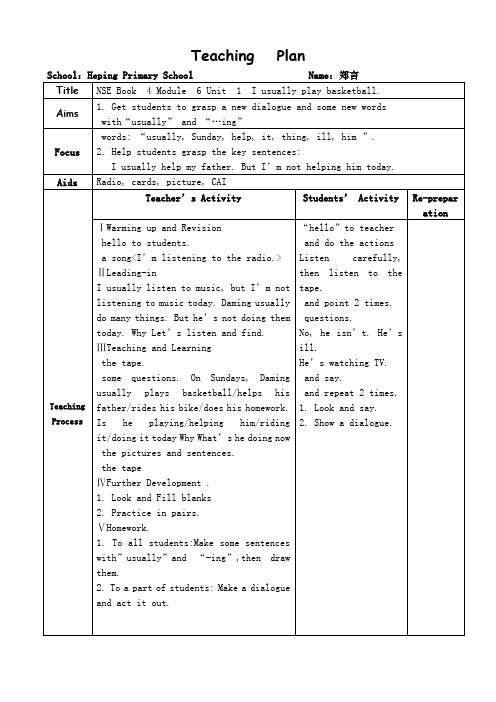
School:Heping Primary School Name:郑言
Title
NSE Book 4Module6Unit1I usually play basketball.
Aims
1. Get students to grasp a new dialogue and some new words
ⅢTeaching and Learning
the tape.
some questions. On Sundays, Daming usually plays basketball/helps his father/rides his bike/does his homework. Is he playing/helping him/riding it/doing it todayWhy What’s he doing now
ⅡLeading-in
I usually listen to music, but I’m not listening to music today. Daming usually do many things. But he’s not doing them today. WhyLet’s listen and find.
with“usually” and “…ing”
Focus
words:“usually, Sunday, help, it, thing, ill, him”.
2. Help students grasp the key sentences:
I usually help my father. But I’m not helping him today.
2. To a part of students: Make a dialogue and act it out.
Book4 Module10 Unit1教案新部编本
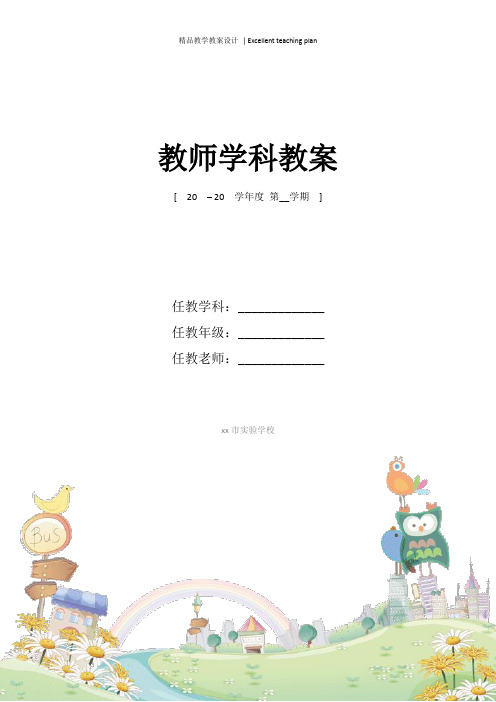
i.知识目标:places
ii.技能目标:fin生学习英语的兴趣,形成良好的学习习惯。
Focus
教学
重难点
i.巩固本课的单词、句子:cousin supermarket in front of next to
It’s next to the park.It’s in front of the school.
3.Action
1)divide four team. (分4个角色)
2)no listen.say sentences.
出示课件,look and say .
(学习take the first on the left.)
V.Homework
1)制作一幅从家到学校的地图。
2)以小组为单位编关于finding places的对话。
Listen and act.
Listen and repeat.
Read the text
Find question.
Listen and repeat.
Action.
Say sentences.
Look、say and learn.
Do honework at home.
Re-preparation
教师学科教案
[20 – 20学年度第__学期]
任教学科:_____________
任教年级:_____________
任教老师:_____________
xx市实验学校
Teaching Plan
School:长大小学Name:张鹤
Title
课题
NSE Book4 Module10 Unit1
Aims
Students’Activity
Book 4 Module 1 Teaching plan
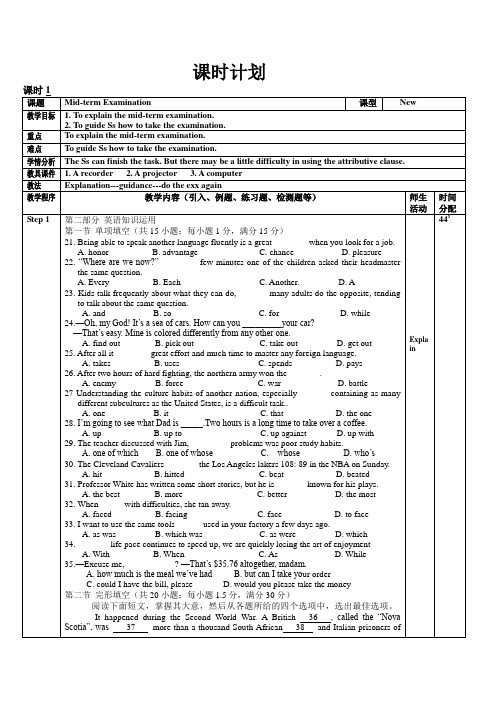
课时计划71. Peer mediators’ work is _____.A. to give lessons to disputantsB. to help find a way to make both sides happyC. to find out who starts a quarrelD. to give students some special training72. What should you do when the other person is speaking?A. Try to tell him or her what you think.B. Think who is right and who is wrong.C. Listen carefully and look at his or her eyes all the time.D. Ask the peer mediators as many questions as possible.EThe Taj Mahal(泰姬陵) is a love story, a sad and beautiful one. If it didn’t exist, we would easily imagine that the story of its construction was simply a fairy tale. Three hundred years ago, there lived an Indian emperor called Shah Jahan. His wife was a beautiful and bright woman whom he loved greatly. Her title was Mumtazl Mahan: its shortened form Taj Mahan, means “pride of the palace”. In the year 1630 this beloved wife of the emperor died. He was so brokenhearted that he thought of giving up his throne. He decided out of his love for his wife, to build her the most beautiful tomb that had ever been seen.He summoned the best artists and architects from India, Turkey, Persia and Arabia and finally, the design was complete. It took more than twenty thousand men working over a period of 18 years to build the Taj Mahan, one of the most beautiful building in the world.The building itself stands on a marble. Platform 29 meters square and 6---7 meters high. Towers rise from each of the four corners. The Taj itself soars another 61 meters into the air. It is a eight-sided building made of white marble.The emperor planned to build an identical tomb of black marble for himself on the other side of the river connected by a silver bridge. However his son put him into a prison in the palace before he could finish, and for the rest of his life, he could only gaze across river at the tomb of his beloved wife.73.The whole passage tells us about ______.A . a beautiful fairy tale B. the story of the Taj MahanC. white and black marble tombs made for the emperor’s wifeD. the love story of emperor Shah Jahan and his wife74. Which of the following statements is NOT true about the Taj Mahan? _____A, It was completed quickly owing to the efforts of the best artists and workers.B, A lot of people took part in the building workC, It is a magnificent building.D, It is a tomb for the emperor’s beloved wife.75. The emperor ____.A. died soon after Taj Mahan diedB. was killed by his sonC. was beloved by his peopleD. died after 1648第II卷(二部分,共35分)第一部分:短文改错(共10小题;每小题1分,满分10分)Visiting a city you have never been before can be 76.___________fun. Finding out information about the city before 77.___________you go and can make the trip more interesting. Most 78.___________cities have a travel office from that you can get many 79.___________useful things. One of the most value things is a map. 80.___________With a map of the city shows its streets, you can 81.___________find your way around. It says about famous places to 82.___________see. It may even give them a short history of the city. 83.___________For example, almost everyone visits New York 84.___________want to go and see the Statue of Liberty. 85.___________ 第二部分:书面表达(满分25分)目前,越来越多的中学生利用周末上各种各样的培训班或请家教。
- 1、下载文档前请自行甄别文档内容的完整性,平台不提供额外的编辑、内容补充、找答案等附加服务。
- 2、"仅部分预览"的文档,不可在线预览部分如存在完整性等问题,可反馈申请退款(可完整预览的文档不适用该条件!)。
- 3、如文档侵犯您的权益,请联系客服反馈,我们会尽快为您处理(人工客服工作时间:9:00-18:30)。
the tape.
some questions. On Sundays, Daming usually plays basketball/helps his father/rides his bike/does his homework. Is he playing/helping him/riding it/doing it today?Why What’s he doing now
the pictures and sentences.
the tape
ⅣFurther Development .
1.Look and Fill blanks
2.Practice in pairs.
ⅤHomework.
1.To all students:Make some sentenceswith”usually”and“-ing”,then draw them.
with“usually” and “…ing”
Focus
words:“usually, Sunday, help, it, thing, ill, him”.
2. Help students grasp the key sentences:
I usually help my father. But I’m not helping him today.
questions.
No, he isn’t. He’s ill.
He’s watching TV.
and say.
and repeat 2 times.
1.Look and say.
2.Show a dialogue.
ⅡLeading-in
I usually listen to music, but I’m not listening to music today. Daming usually do many things. But he’s not doing them today. Why?Let’s listen and find.
Book4 Teaching PlaБайду номын сангаас教学设计教案(总1页)
Teaching Plan
School:Heping Primary School Name:郑言
Title
NSE Book 4Module6Unit1I usually play basketball.
Aims
1. Get students to grasp a new dialogue and some new words
2. To a part of students: Make a dialogue and act it out.
“hello”toteacher
and do the actions
Listen carefully, then listen to the tape.
and point 2 times.
Aids
Radio, cards, picture,CAI
Teaching Process
Teacher’s Activity
Students’ Activity
Re-preparation
ⅠWarming up and Revision
hello to students.
a song<I’m listening to the radio.>
